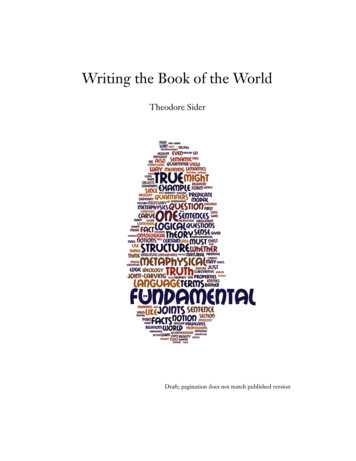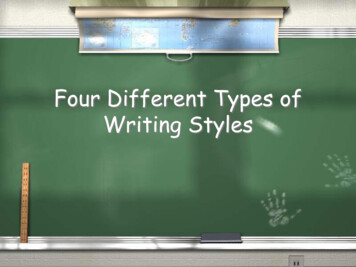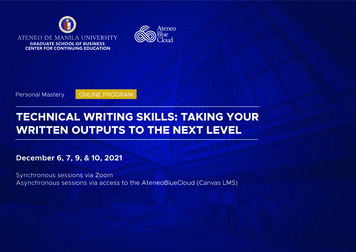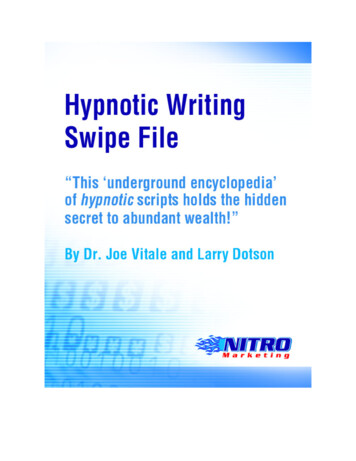
Transcription
Writing the Book of the WorldTheodore SiderDraft; pagination does not match published version
iThe central theme of this book is: realism about structure. The world hasa distinguished structure, a privileged description. For a representation to befully successful, truth is not enough; the representation must also use the rightconcepts, so that its conceptual structure matches reality’s structure. There isan objectively correct way to “write the book of the world”.Realism about predicate structure is fairly widely accepted. Many—especiallythose influenced by David Lewis—think that some predicates (like ‘green’) doa better job than others (like ‘grue’) at marking objective similarities, carvingnature at the joints. But this realism should be extended, beyond predicates, toexpressions of other grammatical categories, including logical expressions. Let“there schmexists an F ” mean that the property of being an F is expressed bysome predicate in some sentence of this book. ‘Schmexists’ does not carve atthe joints; it is to the quantifier ‘there exists’ as ‘grue’ is to ‘green’. Likewise,the question of joint-carving can be raised for predicate modifiers, sententialconnectives, and expressions of other grammatical categories. (Structure is ageneralization and extension of Lewisian naturalness.)I connect structure to fundamentality. The joint-carving notions are thefundamental notions; a fact is fundamental when it is stated in joint-carvingterms. A central task of metaphysics has always been to discern the ultimateor fundamental reality underlying the appearances. I think of this task as theinvestigation of reality’s structure.Questions about which expressions carve at the joints are questions abouthow much structure reality contains. Whether reality contains causal, or ontological, or modal structure is a matter of whether causal predicates, quantifiers(or names), and modal operators carve at the joints. Such questions lie at thecenter of metametaphysics. Those who say that questions of ontology are“merely verbal”, for example, are best regarded as holding that reality lacksontological structure. Such deflationary metametaphysical stances are thusthemselves metaphysical stances. There is no ametaphysical Archimedeanpoint from which to advance deflationary metametaphysics, since any suchmetametaphysics is committed to at least this much substantive metaphysics:reality lacks a certain sort of structure.A subsidiary theme is: ideology matters. There is an unfortunate tendency,perhaps encouraged by bad terminology, to psychologize Quine’s notion ofideology: to regard a theory’s choice of primitive notions—its ideology—asa merely psychological or linguistic or conventional matter (in contrast tothe entities it postulates—its ontology—which is part of its objective content).Philosophers reject their opponents’ ideology in psychological/semantic terms:
ii“I don’t understand what you mean by that.” And when introducing their ownideology, the hurdle to be passed is again psychological/semantic: primitivenotions must be “intelligible”. But there is a squarely metaphysical issue concerning any proposed piece of ideology (including logical and quasi-logicalideology such as modal operators or second-order quantifiers): does realitycontain the requisite structure? If it does, then “intelligibility” in previously“understood” terms is not required for successful reference to and theorizingabout that structure, no more in metaphysics than in physics.A shift of focus from psychological/semantic to metaphysical constraintson ideology is at times liberating for metaphysics, but it also keeps our feet onthe ground, by restraining the tendency to evade ontological commitments byadding to ideology. A fundamental theory’s ideology is as much a part of itsrepresentational content as its ontology, for it represents the world as havingstructure corresponding to its primitive expressions. And the world accordingto an ideologically bloated theory has a vastly more complex structure than theworld according to an ideologically leaner theory; such complexity is not to beposited lightly.Fixating on ontology while ignoring ideology is both too narrow and incautious.1 It is too narrow because the goal of metaphysics is to give a fundamentaldescription of the world, and doing so requires more than merely saying whatthere is. It is incautious because it uncritically assumes that quantificationalstructure is fundamental. If quantificational structure is indeed fundamental(as I think it is), ontology deserves its place in fundamental metaphysics. But ifquantificational structure is not fundamental, then ontological inquiry deserveslittle more attention within fundamental metaphysics than inquiry into thenature of catcher’s mitts.A final theme is a “pure” conception of metaphysics, free of certain encumbrances. One encumbrance is doing metaphysics primarily in modal terms.Against this, there is a growing consensus that modal notions are too coarse formetaphysics, and that notions in the vicinity of “fundamentality”, “in virtue of”,and the like, should not be understood in modal terms. A second encumbranceis linguistic entanglements. Here too, there is a growing consensus: that it isnot so important for metaphysical and linguistic theory to neatly mesh. Thefundamental metaphysics underlying a discourse might have a structure quiteunlike that suggested by the discourse. Whereas a good linguistic theory must1Dorr (2004, section 1) and Schaffer (2009a) make related complaints.
iiifit the suggested structure, good metaphysics must fit the underlying structure.2This book presented an organizational challenge. Theory-then-applicationswould have been neatest, but the concept of structure is unfamiliar enough thatreadability demanded early applications. My compromise was to intermingle.Chapter 1 introduces the concept of structure and describes in a preliminaryway how it will be applied. Chapter 2 begins to present the theory, arguingthat structure is primitive and objective, and defending an epistemology ofstructure. Chapters 3–5 turn to applications, showing how structure illuminatesexplanation and laws, reference, epistemology, physical geometry, substantivity,and metametaphysics. Chapters 6–8 return to theory, arguing that expressionsof any grammatical category (not just predicates) can be evaluated for structure, addressing various abstract questions about how structure behaves, andcriticizing certain rival concepts (such as truthmaking and ground). Chapters9–12 return to applications, showing how the metaphysics of four domains—ontology, logic, time, and modality—looks when conceptualized in terms ofstructure. Chapter 13 concludes with a sketch of a “worldview”: a comprehensive metaphysics cast in terms of structure. As a guide to those who wish toread selectively:The metaphysics of structure: chapters 1, 2, 6–8;Applications: chapters 3–5, 9–12;Metametaphysics: chapters 4–5, 9, and (to a lesser extent) 10–12;Mix of first-order and meta- metaphysics: chapters 9–13.I am grateful to many people for helpful discussions and feedback: FrankArntzenius, Elizabeth Barnes, Paul Boghossian, Craig Callender, Ross Cameron,David Chalmers, David Copp, Troy Cross, Louis deRosset, Janelle Derstine,Cian Dorr, Ant Eagle, Andy Egan, Matti Eklund, Adam Elga, Matt Evans,Delia Graff Fara, Mike Fara, Hartry Field, Hilary Greaves, Liz Harman, AllanHazlett, Eli Hirsch, Thomas Hofweber, Paul Horwich, Alex Jackson, CarrieJenkins, Boris Kment, Tora Koyama, Uriah Kriegel, Heather Logue, OfraMagidor, Ishani Maitra, Colin Marshall, Farid Masrour, Andy McGonigal,Ian McKay, Joseph Melia, Ulrich Meyer, Alan Musgrave, Daniel Nolan, JillNorth, Tim O’Connor, Laurie Paul, Zach Perry, Agustín Rayo, Tony Roark,2Kit Fine’s (1994a; 2001) recent work has been especially influential in forging both consensuses.
ivDan Rothschild, Stephen Schiffer, Michael Schweiger, Adam Sennet, AlanSidelle, David Sosa, Ernie Sosa, Joshua Spencer, Jason Stanley, Irem KurtsalSteen, Steve Steward, Sharon Street, Zoltán Gendler Szabó, Amie Thomasson,Jason Turner, Ryan Wasserman, Brian Weatherson, Ralph Wedgwood, BrunoWhittle, Tim Williamson, Tobias Wilsch, Chris Wüthrich, Stephen Yablo,and Dean Zimmerman. I’m especially grateful to Karen Bennett, GideonRosen, Jonathan Schaffer, and Robbie Williams for extensive and challengingcomments (which, I fear, I have not fully addressed). Thanks also to OxfordUniversity Press and to Blackwell Publishing for permission to include bits ofSider (2003), Sider (2009), and Sider (2007a).I’d also like to thank Kit Fine, John Hawthorne, and Phillip Bricker. I’velearned much from talking to Kit about fundamentality in the past few years,and from thinking through his writings on the subject. John read large portionsof the manuscript and gave me many insightful comments, as well as pushingme, years ago, to go beyond the predicate. Phil directed my dissertation, whichwas on Lewisian naturalness. He taught me the power of this idea, how to applyit to the philosophy of space and time, and much, much more. My intellectualdebt to Phil is massive.Finally, it should be obvious how much this book owes to David Lewis. Hisideas on natural properties and relations have always seemed to me among hisbest: powerful, correct, revolutionary yet deeply intuitive.
Contents1 Structure1.1 Structure: a first look . . . . . . . . . . . . . . . . . . . . . . . . . . .1.2 Philosophical skepticism about structure . . . . . . . . . . . . . .1.3 Structure in metaphysics . . . . . . . . . . . . . . . . . . . . . . . . .2 Primitivism2.1 Understanding . . . . . . . . .2.2 Primitivism supported . . . .2.3 Epistemology . . . . . . . . . .2.4 Against reduction . . . . . . . .2.5 Against subjectivity . . . . . . .2.6 The privilege of the physical1136.111112141822233 Connections3.1 Explanation and laws . . . . . . . . . .3.2 Reference magnetism . . . . . . . . . .3.3 Induction and confirmation . . . . . .3.4 Intrinsic structure in physical spaces.25252841464 Substantivity4.1 Nonsubstantive questions .4.2 Substantivity characterized4.3 Conventionality . . . . . . . .4.4 Subjectivity . . . . . . . . . . .4.5 Epistemic value . . . . . . . .4.6 Objectivity of structure . . .52525464677277.v.
CONTENTSvi5 Metametaphysics5.1 The challenge of metaphysical deflationism5.2 Personal identity, causation . . . . . . . . . . .5.3 The metaphysics room . . . . . . . . . . . . . .5.4 Substantivity in nonfundamental disputes . .5.5 Extended simples . . . . . . . . . . . . . . . . . .5.6 Metametaphysics as just more metaphysics .797986879193976 Beyond the predicate6.1 The reason to generalize . . . . . . .6.2 Inapplicability of the similarity test6.3 No entities . . . . . . . . . . . . . . . .6.4 Unclear epistemology? . . . . . . . .6.5 Logical conventionalism . . . . . . 151152153157162163.168168169170172174.7 Questions7.1 Complete? . . . . . . . . . . . . . . . . . . . . . . . .7.2 Pure? . . . . . . . . . . . . . . . . . . . . . . . . . . . .7.3 Purity and connection . . . . . . . . . . . . . . . . .7.4 Metaphysical semantics . . . . . . . . . . . . . . . .7.5 Completeness and purity reformulated . . . . .7.6 Metaphysics after conceptual analysis . . . . . .7.7 Metaphysical semantics for quantifiers . . . . . .7.8 Metaphysics and the study of language . . . . .7.9 Nonfundamental ground . . . . . . . . . . . . . . .7.10 Subpropositional? . . . . . . . . . . . . . . . . . . .7.11 Absolute? . . . . . . . . . . . . . . . . . . . . . . . . .7.11.1 Absolutism and comparative structure7.11.2 Absolutism and infinite descent . . . . .7.12 Determinate? . . . . . . . . . . . . . . . . . . . . . .7.13 Fundamental? . . . . . . . . . . . . . . . . . . . . . .8 Rivals8.1 Fine’s concepts . . . . . . . . . . . . . . . . .8.2 First Finean view: grounding and reality8.2.1 Ground and purity . . . . . . . . .8.2.2 Ground and infinite descent . . .8.3 Second Finean view: reality . . . . . . . . .
CONTENTS8.48.58.68.7vii8.3.1 Explanation of fundamental truths . . . .8.3.2 Combinatorialism about fundamentality8.3.3 Combinatorialism about determinacy . .8.3.4 No fundamental truths . . . . . . . . . . .8.3.5 Nihilism and deflationism . . . . . . . . .Truthmaking . . . . . . . . . . . . . . . . . . . . . . . .Truthmaking as a theory of fundamentality . . . .Schaffer: entity-grounding . . . . . . . . . . . . . . .Entity-fundamentality . . . . . . . . . . . . . . . . . .1741761781791801811861921959 Ontology9.1 Ontological deflationism . . . . . . . . . . . . . . . . . .9.2 Ontological realism . . . . . . . . . . . . . . . . . . . . .9.3 Ontologese . . . . . . . . . . . . . . . . . . . . . . . . . . .9.4 Predicates not the issue . . . . . . . . . . . . . . . . . . .9.5 Quantifier variance . . . . . . . . . . . . . . . . . . . . . .9.5.1 Quantifier variance and domain restriction9.6 Objections to quantifier variance . . . . . . . . . . . .9.6.1 The semantic argument . . . . . . . . . . . . .9.6.2 No foundation . . . . . . . . . . . . . . . . . . .9.6.3 No epistemic high ground . . . . . . . . . . .9.6.4 Indispensability . . . . . . . . . . . . . . . . . .9.7 Easy ontology . . . . . . . . . . . . . . . . . . . . . . . . .9.8 Analyticity . . . . . . . . . . . . . . . . . . . . . . . . . . .9.9 Against easy ontology . . . . . . . . . . . . . . . . . . . .9.10 Other forms of easy ontology . . . . . . . . . . . . . . .9.11 Metaontology and conceptions of fundamentality .9.12 Ontological commitment . . . . . . . . . . . . . . . . .9.13 Quantifiers versus terms . . . . . . . . . . . . . . . . . .9.14 NonQuinean first-order ontology . . . . . . . . . . . .9.15 Higher-order quantification . . . . . . . . . . . . . . . 3724024224624710 Logic10.1 Fundamental logic . . . . . .10.2 Hard choices . . . . . . . . . .10.3 Nonfundamental metalogic10.4 Logical pluralism . . . . . . .10.5 Objectivity in model theory.256256257264267270.
CONTENTSviii10.6 Classical logic and fundamentality . . . . . . . . . . . . . . . . . . 27311 Time11.1 Presentism . . . . . . . . . . . . . . . . . . . . .11.2 Presentist ideology: quantified tense logic11.3 Is dispute over presentism substantive? . .11.4 Passage . . . . . . . . . . . . . . . . . . . . . . . .11.5 Williamson on saturation and contingency11.6 Change and saturation . . . . . . . . . . . . .11.7 Talk of saturation is legitimate . . . . . . . .11.8 The metaphysics of saturation . . . . . . . .11.9 Varieties of passage . . . . . . . . . . . . . . . .12 Modality12.1 No fundamental modality . . . . . . . . . . . . .12.2 A Humean strategy for reduction . . . . . . . .12.3 Logical consequence and mathematical truth12.4 Analyticity . . . . . . . . . . . . . . . . . . . . . . .12.5 Laws of metaphysics . . . . . . . . . . . . . . . . .12.6 Determinates and determinables . . . . . . . . .12.7 Contextualism . . . . . . . . . . . . . . . . . . . . .12.8 The necessary a posteriori . . . . . . . . . . . . .12.9 Micro-reduction . . . . . . . . . . . . . . . . . . .12.10 De re modality . . . . . . . . . . . . . . . . . . . .12.11 Family resemblances . . . . . . . . . . . . . . . . .12.12 Spreading arbitrariness . . . . . . . . . . . . . . .13 A 323326326331333335337341343344347
Chapter 1Structureetaphysics, at bottom, is about the fundamental structure of reality. Notabout what’s necessarily true. Not about what properties are essential.Not about conceptual analysis. Not about what there is. Structure.Inquiry into necessity, essence, concepts, or ontology might help to illuminate reality’s structure. But the ultimate goal is insight into this structureitself—insight into what the world is like, at the most fundamental level.M1.1 Structure: a first lookDiscerning “structure” means discerning patterns. It means figuring out theright categories for describing the world. It means “carving reality at its joints”,to paraphrase Plato. It means inquiring into how the world fundamentally is,as opposed to how we ordinarily speak or think of it.Consider three objects: two electrons in identical intrinsic states, and a cow.It is the most natural thing in the world to say that the electrons are perfectlysimilar to each other, and that neither is perfectly similar to the cow. The threeobjects should be divided into two groups, one containing the electrons, theother containing the cow. The electrons go together, and neither goes with thecow.Or imagine a universe that is entirely full of fluid. A plane divides theuniverse into two halves, one in which the fluid is uniformly red, the otherin which the fluid is uniformly blue (figure 1.1). Now imagine a group ofpeople who encounter this universe, but accord no special status to the dividingblue-red plane. Instead of thinking of the universe as divided into the red and1
CHAPTER 1. STRUCTURE2Figure 1.1: The red–blue worldFigure 1.2: Bizarre carving of the red–blue worldblue halves, they think of it as being divided in half by a different plane, markedby the dashed line in figure 1.2. And they do not use predicates for red andblue. Instead, they have a pair of predicates that they apply uniformly withinthe two regions separated by their dividing plane. These predicates (whoseextensions are indicated by diagonal hash lines in the diagram) cut across thepredicates ‘red’ and ‘blue’. The regions to the left of the dashed line they call“bred”; the regions to the right they call “rue”.It is almost irresistible to describe these people as making a mistake. Butthey’re not making a mistake about where the red and blue regions are, sincethey make no claims about red or blue. And they make no mistakes when theyapply their own concepts. The regions that they call “bred” are indeed bred,and the regions they call “rue” are indeed rue. The problem is that they’ve
CHAPTER 1. STRUCTURE3got the wrong concepts. They’re carving the world up incorrectly. By failingto think in terms of the red/blue dividing plane, they are missing something.Although their beliefs are true, those beliefs do not match the world’s structure.1.2 Philosophical skepticism about structureAll is well until we encounter a philosopher, who, as usual, asks some uncomfortable questions. Why do the two electrons “go together”, the philosopherwants to know? Yes, they share many features in common: each has 1.602 10 19C charge, 9.109 10 31 kg mass, and so on. But there are plenty of featuresthat the electrons do not share. They are in different locations, travel at different velocities, and are parts of different wholes. And why doesn’t the cow gotogether with the electrons? If all three are located in North America, then allthree share the feature being located in North America. And all three share thefeature: being an electron or a cow.The philosopher continues: what is wrong with carving the red–blue worldalong the diagonal plane? What is wrong with grouping the bred thingstogether and the rue things together? All bred things really are bred; they allshare the feature of being on the left side of the diagonal plane. One might protestthat not all bred things are alike, since some are red and some are blue; butthe philosopher will reply that carving the world along the vertical plane is nobetter on this score. Not all red things are alike, since some are bred and someare rue.In fact, once we get the hang of the philosopher’s way of thinking about“features”, we can see that any two objects share infinitely many features, andalso differ with respect to infinitely many features. For consider any objectsx and y. Where F x and Fy are any features of x and y, respectively, x and yshare the feature: being either F x or Fy . And they share the feature being either F xor Fy or 1 kg mass. And they share the feature being either F x or Fy or 2 kg mass.And so on. So they share infinitely many features. As for the infinitely manyfeatures with respect to which they differ, consider:being F x , and located at Lbeing F x -or-1-kg-mass, and located at Lbeing F x -or-2-kg-mass, and located at L
CHAPTER 1. STRUCTURE4etc.where L is some location occupied by x but not y. Object x has each of thesefeatures; object y lacks each.The crux is obviously the philosopher’s willingness to allow such “features”as being either an electron or a cow, and to treat them on a par with features likebeing an electron and being a cow. If we had nothing but the philosopher’s featuresto go by, then indeed, we wouldn’t be able to make any sense of a “correct” wayto group our three objects, or of the electrons being more similar to each otherthan to the cow. If, on the other hand, we could make a distinction betweengenuine features—features that are fundamental, that carve nature at the joints,whose sharing makes for similarity—and the rest, then we could say what wewant. Can we make this distinction?Concepts and distinctions that resist definition in terms of the popularphilosophical ideology of the day tend to be viewed with suspicion. Thusit was that throughout much of the twentieth century, philosophers tendednot to speak of genuine features. Quine’s extensionalism, for example, whichdominated the 1950s and 1960s, allowed only a meager set of concepts to beused in drawing distinctions (roughly, those of first-order logic plus an array ofscientific predicates). Noticing the presence of disjunction in the definitionsof many philosopher’s features, an extensionalist might begin an attempt tocharacterize genuineness by disqualifying features defined in this way. But whatlanguage do we use to evaluate whether a feature is “defined using disjunction”?Speakers of English must use ‘or’ to define the feature: being an electron orcow, but speakers of a language with a primitive predicate for this feature—‘blurg’, call it—can define the same extension without using ‘or’. Indeed, if thelanguage is strange enough, its speakers would need to use ‘or’ and other logicalconnectives to say things that in English may be said using simple predicateslike ‘cow’ and ‘electron’, just as we must use logically complex predicates ofEnglish to say what they say using ‘blurg’. The extensionalist attempt fails tocharacterize an appropriately language-independent notion of genuineness.1In the 1970s, modality became kosher ideology, and there were renewedattempts to define concepts in the vicinity of structure. For instance, Roderick1The paradigm of first-order logic had perhaps the following additional influence. Thestandard model theory of first-order logic treats the semantic values of (n-place) predicates assubsets of the (n-place Cartesian product of the) domain. Viewed from a purely set-theoreticperspective, the semantic values of the predicates ‘is an electron’ and ‘is an electron or cow’ areon a par: each is a subset of the domain.
CHAPTER 1. STRUCTURE5Chisholm (1976, p. 127) and Jaegwon Kim (1982, pp. 59-60) tried to give amodal definition of the notion of an intrinsic property—a property that an objecthas just by virtue of what it’s like in itself, independently of how it is relatedto other objects. They proposed, roughly, that a property is intrinsic if andonly if it is possibly instantiated by an object that is alone in the world. Butthis definition was shown to be unacceptable. The property of being alone inthe world, and the property of either (being alone in the world and being green) or(not being alone in the world and being blue), satisfy the definition but are extrinsic(Lewis, 1983a).(The 70s’ fixation on modality was doubly unfortunate. Not only aremodal tools too crude;2 they’re also distant from the subject matter of mostof metaphysics. It is needlessly indirect to approach the question of what theworld is like by asking what it must be like and what it might have been like.3 )Since the 1980s many philosophers have become comfortable with a richerideology, one that includes notions in the vicinity of “genuine feature”, “intrinsic property”, and the like. The zeitgeist has been that these notions arelegitimate even if they cannot be defined in other terms. Two Davids have ledthe way.4 David Armstrong (1978a,b) used the traditional doctrine of universals to draw the distinction between genuine and nongenuine features. Somepredicates, like ‘is an electron’, perhaps, stand for universals, Armstrong said;but others do not: there simply is no universal of “being either a cow or anelectron”. Through sheer force of will as much anything, he put realism aboutgenuine features on the map. But as our second David, David Lewis (1983b)showed, Armstrong embedded this insight in a quite independent dialectic: thetraditional debate over the existence of universals and their role in a generalanalysis of predication. According to Lewis, we can incorporate Armstrong’sinsight by admitting a notion of “natural properties and relations” (those properties and relations that carve nature at the joints) without thinking of theseas universals in the traditional sense, and without taking on the (misguided,according to Lewis) project of giving a general analysis of predication. Thenotion of a genuine feature was thus freed from unwanted entanglements.Of course, everyone can agree that there is some difference between being anelectron and being either an electron or a cow. If nothing else, ordinary English2On which see, for instance, Fine (1994a); Restall (1996).I also suspect that the right account of how the world might have been and must be defersto how the world is (chapter 12).4Earlier relevant work includes Quinton (1958); Quine (1969); Putnam (1975d); Bealer(1982, chapter 8).3
CHAPTER 1. STRUCTURE6has a single word for the former attribute. What distinguishes Armstrongand Lewis is that they regard the distinction as objective. Structure, too, is tobe understood as objective. There are hard questions about what objectivityamounts to (some of which will be discussed in chapter 4), but the intuitive ideais clear: whether a property, word, or concept5 carves at the joints has nothingto do with the place of the concept in human languages, conceptual schemes,biology, or anything like that. Thus “fundamental” (which I use more or lessinterchangeably with “joint-carving” and “part of reality’s structure”) signifiesa metaphysical, rather than conceptual, sort of fundamentality. Humans mayneed to acquire other concepts first before they grasp joint-carving ones; andconversely, those concepts we acquire first, or most easily, may fail to carve atthe joints.1.3 Structure in metaphysics: a previewThe goal of this book is to push forward the front of realism about structure. I want to expand our conception of structure’s importance, generalizethe concept of structure, investigate its nature, use it as the foundation of“metametaphysics”, and reconceptualize metaphysics in terms of it.The connection to similarity is only the beginning of the importance of thenotion of structure. As we will see, structure pops up throughout philosophy,in our thinking about reference, epistemology, spacetime, objectivity, and othermatters.Structure is particularly central to metaphysics. The heart of metaphysicsis the question: what is the world ultimately, or fundamentally, like? Andfundamentality is a matter of structure: the fundamental facts are those cast interms that carve at the joints.The truly central question of metaphysics is that of what is most fundamental.So in my terms, we must ask which notions carve perfectly at the joints. By using5Subtleties will come later, but to forestall misunderstanding: 1. Structure is a worldly, notconceptual or linguistic, matter (my informal talk of “notion/word/concept X carves at thejoints” notwithstanding). 2. ‘Structure’ is not a noun; structure is not an entity or stuff (thisvery sentence, and phrases like “how much structure the world contains”, notwithstanding).3. ‘Structure’ and its variants are not predicates—not of properties, nor of any other sorts ofentities (“charge carves at the joints” notwithstanding). 4. My most basic notion of structureis absolute, although I allow a derivative notion that comes in degrees. 5. Structure includesdistinguished monadic features (such as charge), not just relational ones (despite what may besuggested by the term ‘structure’).
CHAPTER 1. STRUCTURE7‘red’ and ‘blue’, we carve more closely to reality’s joints than do the speakers ofthe ‘bred’/‘rue’ language. But we do not thereby carve perfectly at the joints;colors are presumably not perfectly fundamental. To carve perfectly, one mustuse the most fundamental concepts, exp
sive metaphysics cast in terms of structure. As a guide to those who wish to read selectively: The metaphysics of structure: chapters 1, 2, 6–8; Applications: chapters 3–5, 9–12; Metametaphysics: chapters 4–5, 9, and











